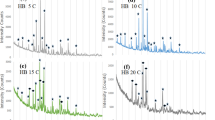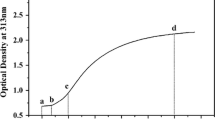Abstract
Hydroxyapatite (HA)-type I collagen (Col) composite is a tissue-engineered bone graft which can act as a carrier or a template structure for cells or any other agents. In this paper, the effect of Col ratio on the scaffold structure and composition was analyzed. Scaffolds composed by HA/Col with different weight ratios (80:20; 50:50; 20:80, and 10:90) were produced by the precipitation method at pH 8–9, 37°C and 6 h of ripening. Using X-ray diffraction data, the Rietveld structure refinement showed that the size of HA crystals along the c-axis direction (002) decreases significantly in the presence of Col. Thus, the HA crystal shape turned from needle-like in pure HA, into spherical, in the 10:90 composite due to Col fibrillogenesis. The homogeneity of the composite was significantly dependent on the amount of Col in it. HA/Col 20/80 composite presented HA particles in a more homogenous way. Such a biocomposite was successfully produced in a rapid way and it is potentially useful for both small tissue repairs and engineering.




Similar content being viewed by others
References
Meyer U, Wiesmann HP, Meyer T. Bone and cartilage engineering. New York: Springer; 2006.
Green D, Walsh D, Mann S, Oreffo ROC. The potential of biomimesis in bone tissue engineering: lessons from the design and synthesis of invertebrate skeletons. Bone. 2002;30:810–5.
Hench LL, Polak JM. Third-generation biomedical materials. Science. 2002;295:1009–14.
Ito Y. Tissue engineering by immobilized growth factors. Mater Sci Eng C. 1998;6:267–74.
Hutmacher DW. Scaffolds in tissue engineering bone and cartilage. Biomaterials. 2000;21:2529–43.
Mcdonough WG, Amis EJ, Kohn J. Critical issues in the characterization of polymers for medical applications. NISTIR-6535, Gaithersburg, MD: U.S. Dept. of Commerce, Technology Administration, National Institute of Standards and Technology; 2000.
Sachlos E, Czernuszka JT. Making tissue engineering scaffolds work. Review on the application of solid freeform fabrication technology to the production of tissue engineering scaffolds. Eur Cells Mater. 2003;5:29–40.
Wang X, Grogan SP, Rieser F, Winkelmann V, Maquet V, La Berge M, et al. Tissue engineering of biphasic cartilage constructs using various biodegradable scaffolds: an in vitro study. Biomaterials. 2004;25:3681–8.
Xu HHK, Simon CG Jr. Self-hardening calcium phosphate composite scaffold for bone tissue engineering. J Orthop Res. 2004;22:535–43.
Goissis G, Maginador SVS, Martins VCA. Biomimetic mineralization of charged collagen matrices: in vitro and in vivo study. Artif Org. 2003;27(5):437–43.
Lawson AC, Czernuszka JT. Collagen-calcium phosphate composites. Proc Inst Mech Eng Part H J Eng Med. 1998;212(6):413–25.
Kobayashi N, Onuma K, Oyane A, Yamazaki A. The role of phosvitin for nucleation of calcium phosphate on collagen. Key Eng Mater. 2004;255:537–40.
Kikuchi M, Suetsugu Y, Tanaka J, Itoh S, Ichinose S, Shinomiya K, et al. The biomimetic synthesis and biocompatibility of self-organized hydroxyapatite/collagen composites. Key Eng Mater. 1999;164–165:393–6.
Wahl DA, Czernuszka JT. Collagen-hydroxyapatite composites for hard tissue repair. Eur Cells Mater. 2006;11:43–56.
Sena LA, Serricella P, Borojevic R, Rossi AM, Soares GA. Synthesis and characterization of hydroxyapatite on collagen gel. Key Eng Mater. 2004;254–256:493–6.
Cui FZ, YJ Ge. Self-assembly of mineralized collagen composites. Mater Sci Eng R. 2007;57(1–6):1–2.
Lowenstam HA, Weiner S. On biomineralization. Oxford: Oxford University Press; 1989. p. 144–67. (Chap. 9).
Landis JL, Silver FH. The structure and function of normally mineralizing avian tendons. Comp Biochem Phys A. 2002;133:1135–57.
Weiner S, Traub W. Crystal size and organization in bone. Connect Tissue Res. 1989;21:259–65.
Zhang W, Liao SS, Cui FZ. Hierarchical self-assembly of nano-fibrils in mineralized collagen. Chem Mater. 2003;15:3221–6.
Cool SM, Forwood MR, Campbell P, Bennett MB. Comparisons between bone and cementum compositions and the possible basis for their layered appearances. Bone. 2002;30(2):386–92.
Hsu FY, Chueh S-C, Wang YJ. Microspheres of hydroxyapatite/reconstituted collagen as supports for osteoblast cell growth. Biomaterials. 1999;20:1931–6.
Legeros RZ. Biological and synthetic apatites. In: Brown PW, Constantz B, editors. Hydroxyapatite and related materials. Boca Raton: CRC Press; 1994. p. 3–28.
Tadic D, Peters F, Epple M. Continuous synthesis of amorphous carbonated apatites. Biomaterials. 2002;23:2553–9.
Danilchenko SN, Moseke C, Sukhodub LF, Sulkio-Cleff B. X-ray diffraction studies of bone apatite under acid demineralization. Cryst Res Technol. 2004;39:71.
Robinson C. Self-oriented assembly of nano-apatite particles: a subunit mechanism for building biological mineral crystals. J Dent Res. 2007;86(8):677–9.
Matsumoto T, Okazaki M, Inoue M, Hamada Y, Taira M, Takahashi J. Crystallinity and solubility characteristics of hydroxyapatite adsorbed amino acid. Biomaterials. 2002;23(10):2241–7.
Veis A. Mineralization in organic matrix frameworks. Rev Mineral Geochem. 2003;54(1):249–89.
Acknowledgements
The authors thank Dr. Virginia C. A. Martins for providing collagen as well as and helpful suggestions. This work was supported by renowned Brazilian agencies such as CNPq, CAPES and FAPERJ.
Author information
Authors and Affiliations
Corresponding author
Rights and permissions
About this article
Cite this article
Sena, L.A., Caraballo, M.M., Rossi, A.M. et al. Synthesis and characterization of biocomposites with different hydroxyapatite–collagen ratios. J Mater Sci: Mater Med 20, 2395–2400 (2009). https://doi.org/10.1007/s10856-009-3813-2
Received:
Accepted:
Published:
Issue Date:
DOI: https://doi.org/10.1007/s10856-009-3813-2




